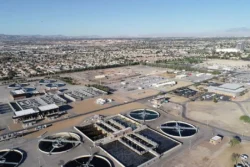Mobile Wastewater Treatment Plant
Mobile Wastewater Treatment Plants: Advancing Sustainable Solutions for Water Management
Introduction
In an era where the management of water resources is of paramount importance, mobile wastewater treatment plants (MWTPs) emerge as a pivotal solution to address the growing needs for flexible, rapid, and on-the-go wastewater processing solutions. The World Health Organization estimates that by 2025, two-thirds of the world’s population may be living under water-stressed conditions. As urbanization increases and infrastructure demands evolve, MWTPs not only promise to mitigate wastewater-related challenges but also play a crucial role in preserving public health and the environment.
This comprehensive article aims to dissect the intricacies of mobile wastewater treatment technology, emphasizing its relevance, operational modalities, benefits, and challenges while providing authoritative insights that are essential for industry professionals.
1. Understanding Mobile Wastewater Treatment Plants
1.1 Definition and Overview
Mobile wastewater treatment plants are portable facilities designed for the treatment of wastewater in various settings, including remote locations, emergency situations, or temporary installations. These systems utilize advanced technologies, including biological, physical, and chemical methods, to effectively treat different types of wastewater, including domestic, industrial, and agricultural effluents.
1.2 Evolution of Mobile Treatment Technologies
Historically, wastewater treatment relied heavily on fixed, large-scale installations. However, increasing demand for immediate and localized solutions has catalyzed the evolution of mobile systems. According to recent industry analysis, the global market for MWTPs is projected to grow at a CAGR of 6.2% from 2020 to 2027, reaching an estimated value of $4 billion by the end of this forecast period. This expansion is fueled by the need for rapid disaster response capabilities, especially in light of climate change-related natural disasters.
1.3 Key Components
Typically, MWTPs consist of an integrated system featuring primary treatment (screening and grit removal), secondary treatment (biological treatment, such as activated sludge or membrane bioreactors),and tertiary treatment (filtration, disinfection). Advanced MWTPs may also incorporate elements for nutrient removal and energy recovery, making them versatile solutions for various wastewater characteristics.
2. Benefits of Mobile Wastewater Treatment Plants
2.1 Flexibility and Adaptability
One of the most compelling advantages of MWTPs is their mobility. As needs evolve, these treatment units can be relocated to address specific challenges, such as natural disasters, industrial demands, or rapid population growth. This flexibility is critical in providing timely solutions in areas where traditional facilities may not be feasible or cost-effective.
2.2 Rapid Deployment in Emergencies
Recent events, including hurricanes and flooding, have underscored the need for swift wastewater management solutions. A 2020 study published in the Journal of Environmental Engineering highlighted that MWTPs could be deployed within 48 hours post-disaster, restoring essential sanitation services more quickly than conventional systems. This immediacy not only protects public safety but also helps to promote overall community resilience.
2.3 Environmental Impact and Resource Recovery
MWTPs also facilitate advanced resource recovery, including the generation of clean water for irrigation or industrial reuse and the extraction of biogas for energy production. Research published in leading environmental engineering journals indicates that incorporating resource recovery processes within MWTPs can significantly reduce the carbon footprint of water treatments by up to 30%, transforming waste into valuable resources.
3. Challenges and Considerations
3.1 Regulatory Compliance
While MWTPs offer promising advantages, navigating the complexities of regulatory compliance can be a significant barrier to their deployment. Different regions have varying standards regarding effluent quality and waste disposal, necessitating a thorough understanding of local regulations. In many cases, temporary permits must be obtained, which can lead to delays in deployment.
3.2 Technology Integration and Maintenance
Ensuring that mobile units function effectively over time requires a comprehensive maintenance schedule and technical expertise. According to the Environmental Protection Agency (EPA), the longevity and reliability of MWTPs hinge on regular monitoring and maintenance, which can overwhelm limited technical staff, especially in remote areas.
3.3 Cost Considerations
While initial investment in MWTPs may appear prohibitive, with unit costs ranging from $500,000 to several million dollars depending on capacity and treatment technologies, the total cost of ownership must factor in benefits over time, including reduced downtime, resource recovery potential, and lower operational costs.
4. Key Questions About Mobile Wastewater Treatment Plants
4.1 How do MWTPs compare to traditional treatment facilities?
MWTPs provide several advantages over conventional systems, including their ability to operate in various environments, lower capital expenditures, and quicker deployment. However, traditional facilities may offer more comprehensive treatment capabilities over a wider range of flows and loads, particularly for large urban areas.
4.2 What types of wastewater can MWTPs handle?
MWTPs are designed to treat a broad spectrum of wastewater, including municipal sewage, industrial effluent, and agricultural runoff. Manufacturers often customize solutions based on the specific characteristics of the influent, ensuring compliance with discharge standards.
4.3 What technologies are integrated into MWTPs?
MWTPs incorporate cutting-edge technologies, such as membrane bioreactors (MBRs), advanced oxidation processes (AOPs), and activated sludge systems, which are crucial for efficient treatment and achieving regulatory compliance.
4.4 What factors should be considered when selecting a mobile treatment plant?
Selection criteria may include treatment capacity, technological compatibility, ease of mobility, energy efficiency, local regulatory requirements, and total cost of ownership, including installation and operational costs.
Conclusion
Mobile wastewater treatment plants represent a transformative approach to managing water resources in a dynamic world. Their flexibility, rapid deployment capabilities, and resource recovery potential make them a critical tool for addressing the pressing challenges posed by urbanization, climate change, and environmental protection. As the industry continues to evolve, overcoming regulatory, technological, and cost challenges will be paramount to fully realize the benefits that MWTPs offer.
Understanding the complexities of these systems is essential for wastewater treatment professionals, policy-makers, and facility managers. By embracing the trends and advancements in mobile treatment technology, stakeholders can not only enhance operational efficiencies but also contribute to a sustainable future in water management. The ongoing development within this sector promises innovative solutions that align with global water security goals, ultimately leading to cleaner ecosystems and healthier communities.

